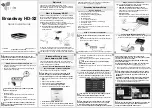
NEO-M9N - Integration manual
Performance of the GNSS antenna and the related front-end RF signal path components have a
decisive impact on the performance of the overall GNSS application. The NEO-M9N module includes
an LTE band 13 notch filter, a SAW filter and an LNA to reduce external RF intereference and
to improve GNSS signal reception sensitivity. The SAW filter is before the LNA in the RF path.
This decreases sensitivity to out-of-band interference and also prevents the LNA from getting into
saturation by very strong interferers.
The included LNA and SAW filter enable the NEO-M9N module to work well with an inexpensive
passive antenna. For applications where passive antenna performance is not sufficient, the module
supports controlling and supplying an external LNA or active antenna.
The NEO-M9N has an internal DC block and 50 Ω impedance matching for GNSS signal input, so
there is no need to add these components to the RF path.
The antenna must have sufficient bandwidth to receive all needed GNSS constellations
, and 50 Ω
impedance at GNSS frequencies.
4.5.1 Antenna design with passive antenna
A design using a passive antenna requires attention to the layout of the RF section. Typically, a
passive antenna is located near electronic components; therefore, care should be taken to reduce
electrical noise that may interfere with the antenna performance. The antenna must have sufficient
bandwidth to receive all needed GNSS constellations. Also, the antenna should have a suitable
ground plane to achieve good performance. Passive antennas do not require a DC bias voltage and
can be directly connected to the RF input pin RF_IN.
The example circuit in
shows a setup for a design with a good passive GNSS antenna.
Figure 32: Passive antenna example circuit
4.5.2 Antenna design with external LNA or active antenna
Passive antenna may be inadequate if the antenna gain is low or if the antenna must be placed far
away from the module. For such designs the NEO-M9N module supports controlling an additional
external LNA or an active antenna. The antenna control signal pin LNA_EN is active high to enable
the external LNA or the active antenna when the receiver needs GNSS signal. If needed, the VCC_RF
output pin can be used to supply filtered DC bias voltage to these external components. In this case,
the supply voltage of the NEO-M9N module must match the external components' working voltage
(for example, 3.3 V). If the VCC_RF voltage does not match with the supply voltage of the active
antenna, use a filtered external supply.
The external LNA or the active antenna with an integrated LNA requires a power supply that
contributes an additional current of typically 5 to 20 mA to the system's power consumption budget.
1
GNSS L-band frequencies: 1559…1563 MHz; 1573…1578 MHz; 1598…1606 MHz;
UBX-19014286 - R07
4 Design
Page 73 of 95
C1-Public
















































